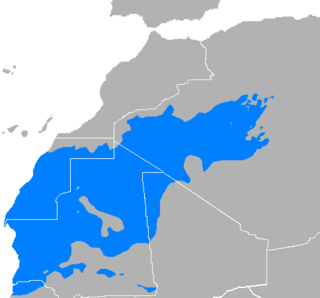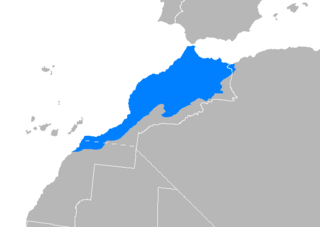 W
WMaghrebi Arabic is a vernacular Arabic dialect continuum spoken in the Maghreb region, in Morocco, Algeria, Tunisia, Libya, Western Sahara, and Mauritania. It includes Moroccan, Algerian, Tunisian, Libyan, and Hassaniya Arabic. It is known locally as Darja, Derdja, Derja, Derija or Darija, depending on the region's dialect.. This serves to differentiate the spoken vernacular from Standard Arabic. The Maltese language is believed to be derived from Siculo-Arabic and ultimately from Tunisian Arabic, as it contains some typical Maghrebi Arabic areal characteristics.
 W
WAlgerian Arabic is a dialect derived from the form of Arabic spoken in northern Algeria. It belongs to the Maghrebi Arabic language continuum and is partially mutually intelligible with Tunisian and Moroccan.
 W
WAlgerian Saharan Arabic is a variety of Arabic indigenous to and spoken predominantly in the Algerian Sahara. Its ISO 639-3 language code is "aao," and it belongs to Maghrebi Arabic.
 W
WHassānīya is a variety of Maghrebi Arabic spoken by Mauritanian Arab-Berbers and the Sahrawi. It was spoken by the Beni Ḥassān Bedouin tribes, who extended their authority over most of Mauritania and Morocco's southeastern and Western Sahara between the 15th and 17th centuries. Hassaniya Arabic was the language spoken in the pre-modern region around Chinguetti.
 W
WJebli (Jebelia) is a pre-Hilalian Arabic dialect spoken in the mountains of northwestern Morocco.
 W
WLibyan Arabic is a variety of Arabic spoken mainly in Libya, and neighboring countries. It can be divided into two major dialect areas; the eastern centred in Benghazi and Bayda, and the western centred in Tripoli and Misrata. The Eastern variety extends beyond the borders to the east and share the same dialect with far Western Egypt. A distinctive southern variety, centered on Sabha, also exists and is more akin to the western variety. Another Southern dialect is also shared along the borders with Niger.
 W
WMaghrebi script refers to a loosely related family of Arabic scripts that developed in the Maghreb, al-Andalus (Iberia), and Biled as-Sudan. Maghrebi script is influenced by Kufic letters, and is traditionally written with a pointed tip, producing a line of even thickness.
 W
WMoroccan Arabic, known as Darija in Morocco, is a form of vernacular Arabic spoken in Morocco. It is part of the Maghrebi Arabic dialect continuum and as such is mutually intelligible to some extent with Algerian Arabic and to a lesser extent with Tunisian Arabic. It is spoken as a first language by about 50% to 75% of Morocco's population. Most other Moroccans natively speak one of the Tamazight languages. Educated Moroccan Tamazight speakers can communicate in mainstream Moroccan Arabic.
 W
WTunisian Arabic, or simply Tunisian, is a set of dialects of Maghrebi Arabic spoken in Tunisia. It is known among its over 11 million speakers as: تونسي, romanized: Tounsi [ˈtuːnsi] (listen), "Tunisian" or Derja "everyday language" to distinguish it from Modern Standard Arabic, the official language of Tunisia. Tunisian Arabic is mostly similar to eastern Algerian Arabic and western Libyan Arabic.